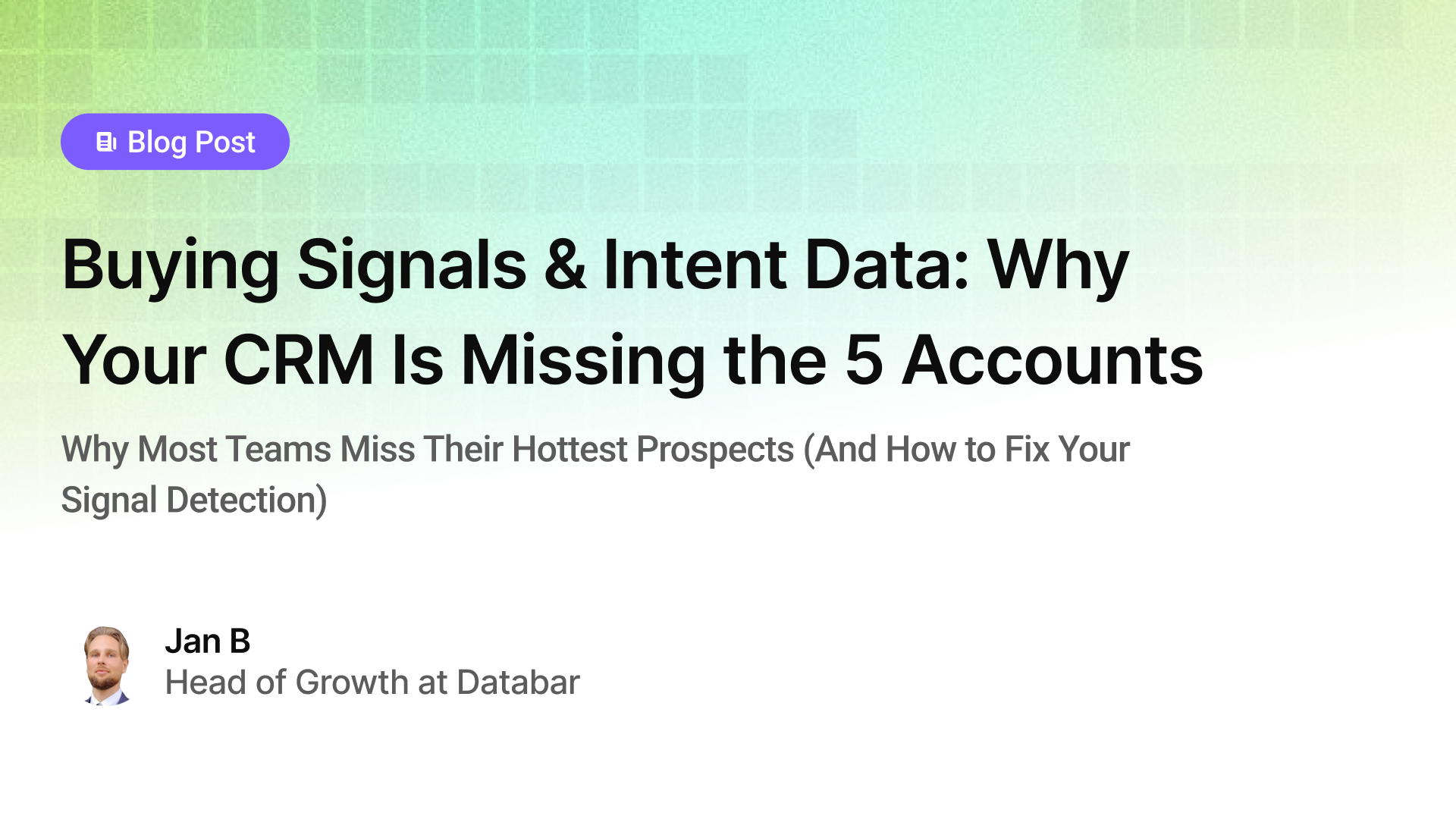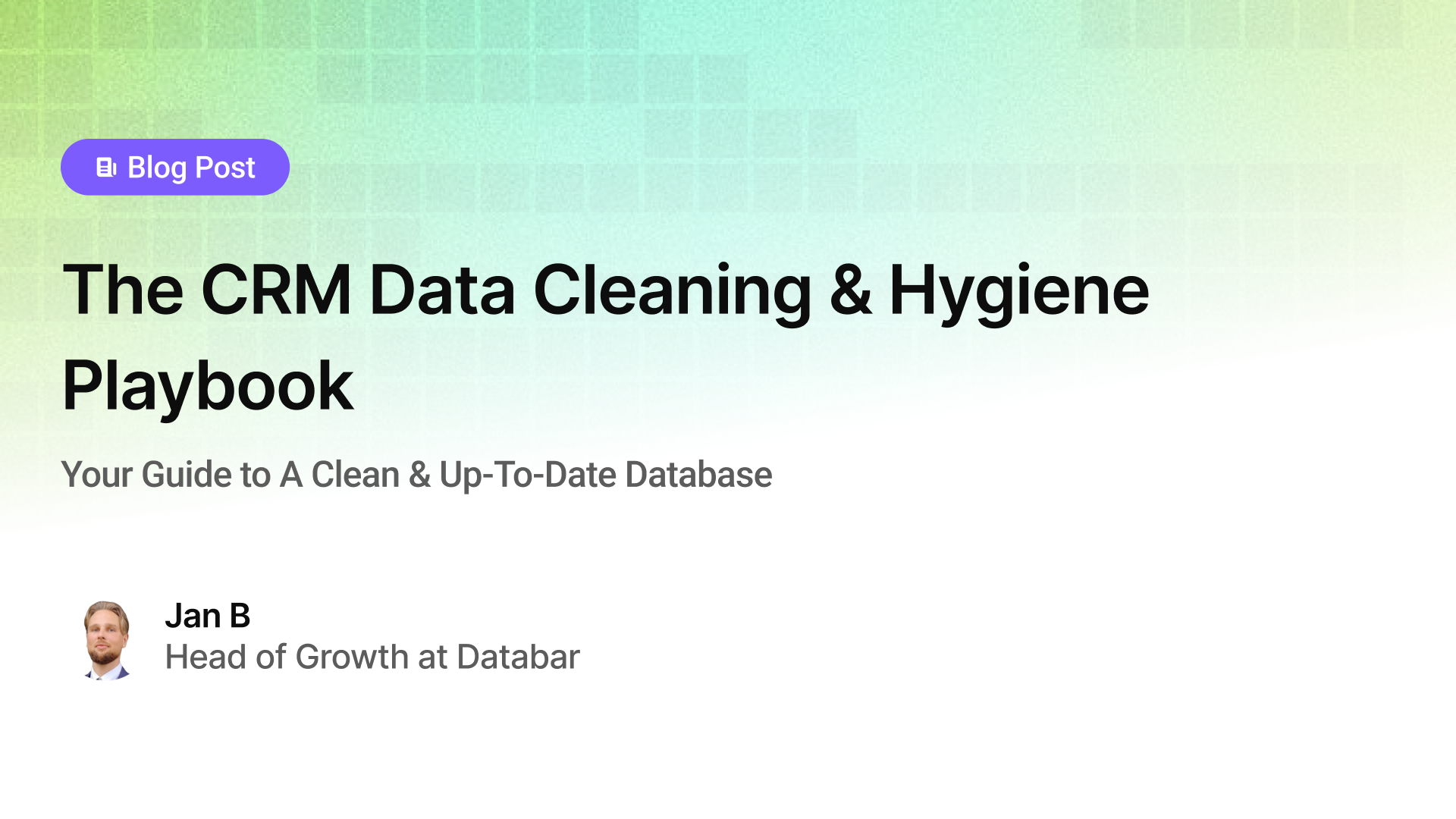Practical AI Sales Applications: Beyond the Buzzwords
Turning AI Concepts into Actionable Sales Strategies
Blogby JanMay 11, 2025

Key Takeaways:
- Practical AI sales applications deliver measurable results: 35% higher response rates and 40%+ reduced prospecting time
- The most effective AI sales workflow optimization tools focus on data enrichment, personalization, and buyer intent detection
- Companies using real-world sales automation report higher quality leads and shortened sales cycles
- Successful implementations focus on specific use cases with measurable ROI rather than chasing AI trends
Are you tired of the AI hype cycle but still curious about how artificial intelligence can actually improve your sales process? You're in good company. While everyone talks about AI transforming sales, few discuss the tangible, practical AI sales applications making a difference today.
This guide cuts through the noise to show exactly how AI is changing real sales workflows. Let's explore what works, what doesn't, and how to implement AI in your sales process without getting lost in empty promises.
The Real State of AI in Sales Today
The sales technology landscape is flooded with tools claiming AI capabilities. According to a Gartner report, 67% of sales leaders plan to increase their AI investments this year, but only 23% feel confident they understand how to implement it effectively.
This disconnect exists because most vendors focus on theoretical benefits rather than practical AI sales applications. The truth is, AI in sales isn't about replacing humans or magically generating revenue—it's about making specific parts of your workflow more efficient.
"The most successful sales teams aren't using AI as a silver bullet but as a scalpel—precisely targeting friction points in their process." - David Abaev, CEO of Databar
What actually works in today's landscape goes beyond the marketing hype:
- Data enrichment automation: Delivers huge time savings with relatively low implementation difficulty
- Email personalization at scale: Generates up to 30%+ higher response rates with medium complexity
- Intent detection and lead scoring: Improve conversion rates while requiring moderate implementation effort
- Conversation intelligence: Can boost close rates though requiring more advanced implementation
- Automated follow-ups: Reduce lost opportunities with minimal implementation challenges
These aren't theoretical gains but they represent the real impact of AI sales workflow optimization when properly implemented.
Data Enrichment: The Foundation of AI Sales Intelligence
Let's start with a simple truth: your sales process is only as good as your data. This is where AI sales workflow optimization truly shines.
Traditional data enrichment involves hours of manual research across multiple platforms. Modern AI-powered tools transform this process entirely. They automatically find and verify contact information while simultaneously pulling company details and technographics from multiple sources. Advanced systems identify buyer intent signals based on online behavior and seamlessly match prospects to your ideal customer profile.
The best part? This happens automatically in the background while your team focuses on high-value activities.
How it works in practice: When a list of target accounts is uploaded to an AI-powered platform, within minutes the system provides verified emails, phone numbers, company size data, technology stack information, and recent news for each company—all without manual searching or research. This converts what was once days of work into an automated process requiring minimal oversight.
Personalization at Scale: Beyond Mail Merge
Generic outreach is dead. According to SalesLoft, personalized emails have a 32% higher reply rate than templated ones. But true personalization takes time—or it used to.
Real-world sales automation tools now allow teams to personalize hundreds of outreach messages daily without sacrificing quality. The transformation happens across multiple dimensions of the sales process.
Modern AI can analyze prospect data and generate custom content that resonates with recipients in several key ways:
- Dynamic content generation: Creates custom introduction paragraphs referencing recent company news, achievements, industry challenges, mutual connections, and engagement history
- Contextual recommendations: Suggests optimal subject lines, calls-to-action, content to share, and ideal sending times based on data analysis
- Multi-channel coordination: Orchestrates personalized touchpoints across email sequences, LinkedIn engagement and phone calls
The results speak for themselves: Companies implementing AI-driven personalization across their outreach channels regularly see 40% increases in meeting bookings. These systems automatically reference recent funding announcements, executive changes, and industry news in every message—something SDR teams simply cannot accomplish manually at scale.
Intent Detection and Predictive Prioritization
One of the most powerful practical AI sales applications is identifying which prospects are actually ready to buy—before they even tell you.
Modern tools analyze thousands of signals to predict purchase intent, fundamentally changing how sales teams prioritize their efforts. These platforms track:
- Digital engagement signals: Website visit patterns, webinar attendance and more
- Competitive indicators: Research of alternative solutions, comparison page visits
- Organizational triggers: Relevant hiring patterns, technology adoption signals, social media activity
This comprehensive approach creates a complete picture of buying intent that far surpasses traditional lead scoring models.
This intelligence helps sales teams focus on the right prospects at the right time, dramatically increasing efficiency. Instead of working through a static list of leads, sales reps receive dynamically prioritized queues each day, with AI continuously recalculating which prospects deserve immediate attention based on fresh intent signals. This ensures high-intent buyers receive prompt attention while others are nurtured appropriately.
Conversation Intelligence: Real-time Guidance
Moving beyond AI buzzwords, conversation intelligence tools provide practical assistance during actual sales conversations.
These sophisticated systems analyze call recordings to identify successful patterns across hundreds or thousands of conversations. The insights gleaned from this analysis power real-time coaching during active calls, suggesting effective responses to common objections at the moment they arise.
Conversation intelligence transforms sales calls in several critical ways:
- Real-time coaching: Provides in-the-moment guidance on handling objections and positioning value
- Topic tracking: Monitors discussion of key products, features, competitors, and decision factors
- Administrative automation: Handles note-taking, action item creation, and CRM updates automatically
- Performance analysis: Identifies patterns in successful vs. unsuccessful calls to improve training
According to Forrester, teams using conversation intelligence see 29% shorter ramp times for new reps and 27% higher quota attainment. The practical application is transformative: New sales reps receive on-screen prompts during calls suggesting how to address specific objections, along with relevant case studies to reference. Post-call, the system automatically updates the CRM with key discussion points and next steps, ensuring nothing falls through the cracks.
How Databar.ai Delivers Practical AI for Sales Teams
When implementing AI sales workflow optimization, choosing the right technology platform is crucial. Databar.ai represents the new generation of tools designed specifically for practical AI applications in sales.
What makes platforms like Databar.ai effective is their integrated approach to sales automation:
- Consolidated data access: Rather than juggling multiple subscriptions, access 90+ premium data providers through a single platform
- Intelligent enrichment: "Waterfall enrichment" technology checks multiple providers sequentially, increasing match rates from 50-60% to over 80%
- AI-powered personalization: Automatically analyze prospect data like LinkedIn posts to create genuinely personalized outreach
- Seamless workflow integration: Connect directly with your existing CRM, email tools, and marketing platforms
This integrated approach addresses the most time-consuming aspects of sales prospecting. Instead of spending hours manually researching contacts and companies, sales teams can build targeted prospect lists with verified contact information in minutes, allowing them to focus on high-value conversations and relationship building.
As one sales leader using AI-enhanced workflows reported: "We've cut our prospecting time by 70% while seeing a 35% increase in response rates—not by sending more messages, but by sending better ones."
Implementation: Starting with Practical AI Applications
Looking to implement AI in your sales workflow? A practical, phased approach yields the best results.
Step 1: Identify Your Friction Points
Before exploring AI solutions, document where your team actually spends their time. Analyze how many hours go to manual research and what percentage of outreach receives no response. Identify exactly where deals commonly stall in your pipeline and which tasks your top performers consistently dislike most. This assessment creates a clear roadmap for targeted AI implementation.
Step 2: Start with Data Foundation
The most successful AI sales workflow optimization begins with a solid data strategy:
- Implement AI-powered data enrichment as your first priority
- Establish clear data quality standards across your organization
- Connect your existing tools and CRM to this enhanced data foundation
- Train your team on effective data interpretation
This foundation supports all subsequent AI initiatives.
Step 3: Introduce Personalization
Once your data infrastructure is solid, introduce personalization capabilities:
- Start with email personalization as your first use case
- Experiment with different AI-generated approaches
- Measure response rates against control groups
- Gradually expand to other channels as you validate results
Step 4: Add Intelligence Layers
Only after mastering these basics should you explore more advanced intelligence layers:
- Intent scoring and prioritization systems
- Conversation intelligence and coaching
- Advanced forecasting and pipeline analysis
- Deal-specific guidance and recommendations
This phased approach ensures sustainable adoption and measurable results at each implementation stage.
Beyond the Hype: Measuring What Matters
The ultimate test of practical AI sales applications isn't how impressive they sound—it's whether they improve your bottom line.
Establish clear KPIs before implementation to measure impact effectively:
|
Metric |
Target Improvement |
Measurement Method |
|
Prospecting time |
-40% |
Time tracking |
|
Response rates |
+30% |
Email analytics |
|
Meetings booked |
+25% |
Calendar metrics |
|
Deal cycle length |
-20% |
CRM analysis |
|
Win rates |
+15% |
Before/after comparison |
|
Revenue per rep |
+20% |
Quarterly performance |
A recent report from Salesforce found that B2B companies implementing AI sales workflow optimization consistently report remarkable improvements: 42% reduction in research time, 37% higher email open rates, 29% more meetings booked, and 22% increase in pipeline value. These aren't isolated success stories but representative of what's possible with strategic implementation.
What makes these organizations successful isn't just the technology—it's their methodical approach to implementation and measurement. They establish clear baselines, implement incrementally, measure continuously, and adjust strategy based on results. This disciplined approach separates genuine AI success stories from failed implementations.
Common AI Sales Workflow Pitfalls to Avoid
As you explore AI sales workflow optimization, several common pitfalls threaten success. Awareness of these challenges improves your odds of effective implementation.
1. The "AI Will Fix Everything" Syndrome
No technology can fix fundamental issues with your value proposition, market fit, or sales strategy. AI amplifies good processes—it doesn't create them. Organizations with broken sales fundamentals often find AI merely accelerates their problems rather than solving them.
2. Tool Overload
More isn't better when it comes to AI implementation. Companies with the best results typically use 2-3 well-integrated AI tools rather than a dozen disconnected solutions. Focus on depth of integration rather than breadth of functionality for maximum impact.
3. Ignoring the Human Element
Real-world sales automation works best when it enhances human capabilities rather than replacing them. The goal should be giving your team superpowers, not sidelining them. The most successful implementations augment human judgment rather than attempting to replace it.
4. Neglecting Training
Even the best AI tools require proper onboarding and adoption strategies. Budget time and resources for comprehensive training programs that build both technical competence and psychological comfort with AI-assisted workflows. This investment pays dividends through improved adoption and utilization.
The Future of AI in Sales: Practical Predictions
Looking beyond current practical AI sales applications, several emerging trends will reshape sales technology in the coming years:
- True omnichannel orchestration: Future AI systems will seamlessly coordinate personalized outreach across all channels, automatically adapting to prospect preferences and engagement patterns
- Buyer-specific playbooks: Instead of generic sequences, AI will create dynamic, prospect-specific playbooks that evolve based on engagement, considering buying stage, communication preferences, and competitive factors
- Advanced conversation intelligence: Real-time guidance during sales calls will become more sophisticated, with AI suggesting specific value propositions based on prospect responses and conversation analysis
- Autonomous deal coaching: AI will provide personalized guidance for each opportunity, suggesting next steps, risk mitigation strategies, and competitive positioning based on historical deal patterns
These advancements aren't science fiction—they represent the natural evolution of current technologies as they mature and integrate more deeply with sales processes.
Making AI Work for Your Sales Team
The difference between empty AI promises and practical AI sales applications comes down to implementation strategy. Several critical success factors distinguish effective implementations from disappointing ones:
- Start with a specific pain point rather than attempting wholesale transformation
- Measure current performance rigorously to establish a credible baseline
- Choose tools that integrate seamlessly with your existing technology stack
- Implement in phases with clear success criteria for each stage
- Gather feedback continuously and iterate based on user experience
Remember that AI should make your sales team more effective, not replace their expertise. The best implementations enhance human capabilities rather than attempting to automate everything. Technology should handle repetitive tasks while empowering humans to focus on relationship building, complex problem solving, and creative deal structuring.
Conclusion: Moving Beyond AI Buzzwords to Real Results
When it comes to AI sales workflow optimization, the companies seeing real results are those focusing on practical applications rather than futuristic promises.
The most successful organizations use AI strategically to eliminate low-value manual tasks that consume precious selling time. They leverage automation to scale personalization without sacrificing quality or authenticity. Their systems focus attention on the highest-potential opportunities based on data rather than intuition. Perhaps most importantly, they provide actionable guidance to sales teams rather than vague insights.
By looking beyond AI buzzwords and focusing on specific, measurable improvements to your workflow, you can achieve significant gains in productivity and results. Start small, measure diligently, and expand based on proven success. This methodical approach yields sustainable improvement rather than fleeting excitement followed by disappointment.
Ready to implement practical AI sales applications in your workflow? Begin by identifying your biggest sales friction points, then explore solutions like Databar.ai that can address these specific challenges. With the right approach to AI implementation, you can join the growing number of organizations achieving remarkable improvements in sales efficiency and effectiveness.
Start your journey with Databar.ai today and experience how practical AI applications can transform your sales process from time-consuming manual tasks to streamlined, data-driven workflows that deliver measurable results.
Related articles

Buying Signals & Intent Data: Why Your CRM Is Missing the 5 Accounts
Why Most Teams Miss Their Hottest Prospects (And How to Fix Your Signal Detection)
by Jan, October 06, 2025

Lead Scoring & Account Segmentation: Why Most CRMs Get This Backward (And How to Fix It)
How to build a system that tells your team who to call, when, and why
by Jan, October 06, 2025

The CRM Data Cleaning & Hygiene Playbook
Your Guide to A Clean & Up-To-Date Database
by Jan, October 04, 2025

Everything You Need To Know About CRM Enrichment
Your Step-By-Step Guide To CRM Data Enrichment
by Jan, October 03, 2025